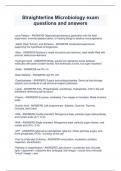Straighterline Microbiology exam
questions and answers
Louis Pasteur - ANSWERS Disproved spontaneous generation with his flask
experiment. Invented pasteurization, or heating things to destroy microorganisms.
Jablot, Redi, Schultz, and Schwann - ANSWERS Conducted experiments
supporting the hypothesis of biogenesis.
Atom - ANSWERS Nucleus is made of protons and neutrons, outer shells filled with
protons. #electrons=#protons
Hydrogen bond - ANSWERS Weak, results from attractive forces between
molecules with polar covalent bonds. Not technically a bond, but super important.
Acidic - ANSWERS low Ph, H+
Basic/Alkaline - ANSWERS high Ph, OH-
Carbohydrates - ANSWERS Sugars and polysaccharides. Serve as food storage
(starch) and contribute to cell structural support (cellulose).
Lipids - ANSWERS Fats, Phospholipids, and Waxes. Hydrophobic. Chill in the cell
membrane reinforcing cell structure.
Poteins - ANSWERS Enzymes, antibodies. Four stages in formation. Made of amino
acids
Nucleic Acid - ANSWERS Cell programmers. Adenine, Guanine, Thymine,
Cytosine, and Uracil.
DNA - ANSWERS Double stranded. Nitrogenous base, pentose sugar (deoxyribose)
and nucleic acids (A-T, C-G)
RNA - ANSWERS Single stranded. Nitrogenous base, pentose sugar (ribose), and
nucleic acid (A-U, C-G)
ATP - ANSWERS Adenosine triphosphate. Adenine, ribose (pentose sugar), and
three phosphates (PO4). "currency of the cell"
Five I's of Microbe Culturing - ANSWERS Innoculation, incubation, isolation,
inspection, identification.
Pathway of magnification - ANSWERS Light source-->condenser lens (focuses
light)-->specimen-->objective lens (enlarged, real image)-->ocular lens (mirrored/
"virtual" image)-->eye
, Bacteria - ANSWERS cell membrane, cytoplasm, chromosome(s), usually cell wall
(with peptidoglycan), cytoskeleton, glycolax.
monotrichous flagella - ANSWERS A subtype of polar flagella. A single flagella
Lopotrichous flagella **lo·phot·ri·chous - ANSWERS Subtype of polar flagella, tufts
of flagella emerging at the same site.
Peritrichous Flagella **pe·rit·ri·chous** - ANSWERS flagella randomly dispersed all
over cell
Periplasmic Flagella/Axial Filaments - ANSWERS Enclosed in the space between
cell wall and cell membrane. Twist to move the cell? It's all very confusing.
Gram stain - ANSWERS crystal violet, iodine, alcohol, safranin. G+ has thick
peptidoglycan layer and stains 'blue', G- has inner and outer membrane and stains
'red'. They don't really, it's more like purple and pink.
Mycoplasmas - ANSWERS naturally lack a cell wall
Lipopolysaccharides (LPS) - ANSWERS present in G- cell walls, sometimes
referred to as endotoxin because it stimulates shock reactions in human hosts.
Enzymes - ANSWERS Catalyst macromolecules. Reusable. Provides reaction site
for substrates.
Protozoa - ANSWERS Generally microscopic single celled prokaryotes. Reproduce
asexually and sexually during different parts of their life cycle.
Endoplasm - ANSWERS Contains nucleus, mitochondria, and vacuoles. Interior of
protozoan.
Ectoplasm - ANSWERS Involved in feeling, protection, and locomotion. Exterior of
protozoan.
Mastigophora/Zoomastigophora - ANSWERS Motility: flagella and amoeboid. If
sexual reproduction then by syngamy (division by longitudinal fission). Some
parasitic and lacking mitochondria and golgi bodies. Many cyst forming.
Trypanosoma, Trichomonas, Giardia.
Sarcodina/Amoebas - ANSWERS Motility: pseudopods, sometimes flagella.
Foraminifera and radiolarians responsible for chalk deposits in ocean. Entamoeba
human parasite.
Apicomplexa/Sporozoa - ANSWERS No motility. Complex life cycles. Sporozoites
important in infection transmission. Thick walled zygotes called oocysts all parasitic.
Plasmodium/malaria, Toxoplasmosis gondii/ toxoplasmosis.




